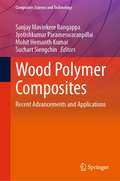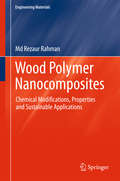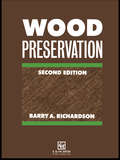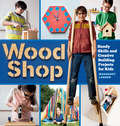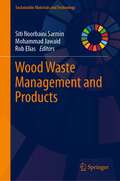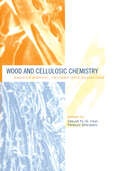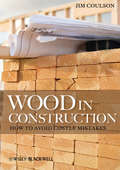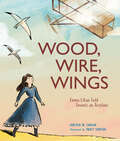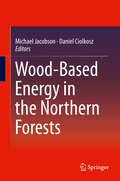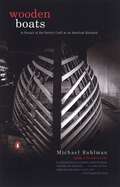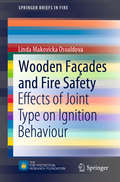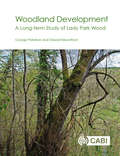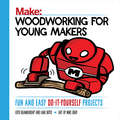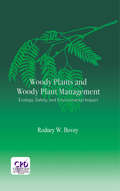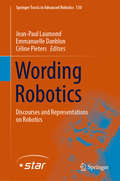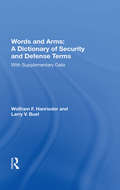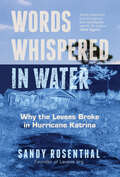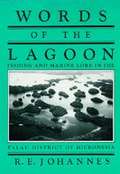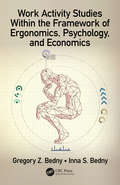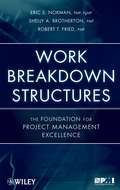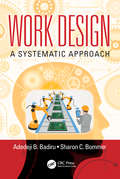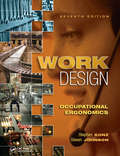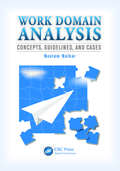- Table View
- List View
Wood Polymer Composites: Recent Advancements and Applications (Composites Science and Technology)
by Jyotishkumar Parameswaranpillai Suchart Siengchin Sanjay Mavinkere Rangappa Mohit Hemanth KumarThis book comprehensively covers the different topics of wood polymer composite materials mainly synthesis methods for the composite materials, various characterization techniques to study the superior properties and insights on potential advanced applications. It also discusses the chemistry, fabrication process, properties, applications, recycling and life cycle assessment of wood polymer composites. This is a useful reference source for both engineers and researchers working in composite materials science as well as the students attending materials science, physics, chemistry and engineering courses.
Wood Polymer Nanocomposites
by Md Rezaur RahmanThis book shows how chemical modifications influence some properties of wood nanocomposites. It describes suitable and effective chemical modifications that strengthen the physico-mechanical, thermal and morphological properties of wood. The authors provide intuitive explanation of the various types of chemical modifications applied to polymer cell walls in wood. They emphasize the reaction changes in wood cell walls due to the chemical modifications. Increased mechanical strength, improved thermal stability as well as the efficient retardancy against fungi attack are described. This book concludes summarizing the potential applications of wood-based nanocomposites taking into account sustainability and economic aspects.
Wood Preservation
by B A RichardsonThe new edition of this comprehensive study of national and international research and application into wood preservation is both well detailed and broad in coverage. The text covers the history of preservation: the anatomy of timbers and their breakdown, preservation principles, materials and methods.
Wood Shop: Handy Skills and Creative Building Projects for Kids
by Margaret LarsonCome on, kids: grab a hammer, step up to the workbench, and get ready to measure, saw, drill, and make cool things! Wood Shop is an exciting introduction for today’s kids to an age-old tradition: building with wood. With step-by-step photographs and clear instructions, aspiring woodworkers learn essential skills such as how to drive a nail, use a power drill, “measure twice, cut once,” and saw correctly. Then the fun begins, with 17 cool and creative projects kids can build to furnish the wood shop, decorate their bedrooms and homes, and create their own play equipment. Favorite projects include Tic-Tac-Toe-To Go!, One-Board Birdhouse, a Tool Tote, and a hanging Twinkle Light. Wood Shop is the perfect gift for tinkerers, young makers, fans of LEGO toys, and aspiring carpenters and engineers. This publication conforms to the EPUB Accessibility specification at WCAG 2.0 Level AA.
Wood Waste Management and Products (Sustainable Materials and Technology)
by Mohammad Jawaid Siti Noorbaini Sarmin Rob EliasThis book examines the application of wood waste in various advancements in environmental fields, such as construction, renewable energy, bio-absorbent, and agricultural and wood-based material. Featuring illustrations, and tables summarizing the latest research, it gathers up-to-date information on the application of various types of wood waste which could be applied in a practical manner to materially reduce nuisance created by fallout of wood-based industries from different sources. Given its scope, the book is a valuable reference book for research students and reference resources for researchers, academics, and industrial scientists working in the field of wood waste management and their utilization.
Wood and Cellulosic Chemistry, Revised, and Expanded
by David N.S. Hon Nobuo ShiraishiThis text details the principal concepts and developments in wood science, chemistry and technology. It includes new chapters on the chemical synthesis of cellulose and its technology, preservation of wood resources and the conservation of waterlogged wood.
Wood in Construction: How to Avoid Costly Mistakes
by Jim CoulsonWood in Construction – How to Avoid Costly Mistakes focuses on the basic principles and appropriate use of wood in construction and illustrates how to avoid or minimise problems, to ensure that wood performs as expected when used in a construction application. Based on the author’s extensive experience of manufacturing processes and practical applications in the timber, construction, joinery, shop-fitting and furniture industries, Wood in Construction provides a guide to using wood in building in the real world. It describes the main causes of difficulty when using wood, and shows how to avoid or minimise problems, reducing the difficulties for the architect, engineer or specifier, builder and building owner. Technical enough to explain why things should be done in specific ways, but also practical enough to demonstrate how to use wood correctly and avoid doing the wrong things, this is an invaluable resource for construction specifiers (architects, engineers), carpenters, structural engineers, building surveyors, small/medium sized builders.
Wood, Wire, Wings: Emma Lilian Todd Invents an Airplane
by Kirsten W. LarsonThis riveting nonfiction picture book biography explores both the failures and successes of self-taught engineer Emma Lilian Todd as she tackles one of the greatest challenges of the early 1900s: designing an airplane.Emma Lilian Todd's mind was always soaring--she loved to solve problems. Lilian tinkered and fiddled with all sorts of objects, turning dreams into useful inventions. As a child, she took apart and reassembled clocks to figure out how they worked. As an adult, typing up patents at the U.S. Patent Office, Lilian built the inventions in her mind, including many designs for flying machines. However, they all seemed too impractical. Lilian knew she could design one that worked. She took inspiration from both nature and her many failures, driving herself to perfect the design that would eventually successfully fly. Illustrator Tracy Subisak's art brings to life author Kirsten W. Larson's story of this little-known but important engineer.
Wood-Based Energy in the Northern Forests
by Michael Jacobson Daniel CiolkoszThis unique book provides the first comprehensive overview of wood based bioenergy in the northern hardwood forests of the Eastern United States. This includes a holistic look at the topic of wood based bioenergy, as well as focused analyses of key topics. This book is relevant to engineers, project developers, foresters, economists, sociologists, environmental scientists and natural resource managers. Most chapters also provide practical hands-on advice for the practitioner, and provide a valuable resource for anyone who is considering developing a woody bioenergy project.
Wooden Boats: In Pursuit of the Perfect Craft at an American Boatyard
by Michael RuhlmanThere are fewer than 10,000 wooden boats in America, but the circulation of WoodenBoat magazine exceeds 180,000. What is it about these boats that has captured the popular imagination? With his "lively blend of reportage [and] reflection" (Los Angeles Times), Michael Ruhlman sets off for a renowned boatyard in Martha's Vineyard to follow the construction of two boats-Rebecca, a 60-foot modern pleasure schooner, and Elisa Lee, a 32-foot powerboat. Filled with exquisite details and stories of the sea, this exciting exploration of a nearly forgotten craft and the colorful personalities involved will enthrall wooden boat owners as well as craftspeople of every stripe, nature enthusiasts, and fans of compelling nonfiction.
Wooden Façades and Fire Safety: Effects of Joint Type on Ignition Behaviour (SpringerBriefs in Fire)
by Linda Makovicka OsvaldovaThis book presents the results of an experiment assessing the impact of spruce wood joints on the creation and development of fire when these joints are applied within a façade. The book includes an extensive analysis of wooden cladding, which is a flammable material in which the elements are connected lengthwise using various types of joint. The parameters of the experiment, as well as the setting, material criteria and evaluation criteria are described in detail. The results confirm that the joint type used has an impact on the selected evaluation criteria and thus also on the potential spread of fire.
Woodland Development
by George F. Peterken Edward P. MountfordIn 1944 Lady Park Wood (45 hectares of woodland in Gloucestershire and Monmouthshire, UK) was set aside indefinitely by the Forestry Commission so that ecologists could study how woodland develops naturally. Since then, in a unique long-term study, individual trees and shrubs have been recorded at intervals, accumulating a detailed record of more than 20,000 individual beech, sessile oak, ash, wych elm, small-leaved lime, large-leaved lime, birch, hazel, yew and other species. In the seven decades since the study started, the wood has changed; trees grew, died and regenerated, and drought, disease and other events shaped its destiny. Each tree and shrub species reacted in its own way to changes in the wood as a whole and to changes in the fortunes of its neighbours. Meanwhile, the wild fauna, flora and fungi also responded, leaving the wood richer in some groups but poorer in others. In this landmark book, beautifully illustrated throughout, George Peterken and Edward Mountford, summarise the ongoing results of the Lady Park Wood study, highlighting its unique place in nature conservation and its significance to ecology in general. It also builds on experience at Lady Park Wood and elsewhere to discuss in particular: the role and maintenance of long-term ecological studies; the concept and form of natural woodland; the role of minimum-intervention policies in woodland nature conservation; near-to-nature forestry; and the desirability and practicalities of re-wilding woodlands.
Woodland Development: A Long-term Study of Lady Park Wood
by George Peterken Edward MountfordIn 1944 Lady Park Wood (45 hectares of woodland in Gloucestershire and Monmouthshire, UK) was set aside indefinitely by the Forestry Commission so that ecologists could study how woodland develops naturally. Since then, in a unique long-term study, individual trees and shrubs have been recorded at intervals, accumulating a detailed record of more than 20,000 individual beech, sessile oak, ash, wych elm, small-leaved lime, large-leaved lime, birch, hazel, yew and other species. In the seven decades since the study started, the wood has changed; trees grew, died and regenerated, and drought, disease and other events shaped its destiny. Each tree and shrub species reacted in its own way to changes in the wood as a whole and to changes in the fortunes of its neighbours. Meanwhile, the wild fauna, flora and fungi also responded, leaving the wood richer in some groups but poorer in others. In this landmark book, beautifully illustrated throughout, George Peterken and Edward Mountford, summarise the ongoing results of the Lady Park Wood study, highlighting its unique place in nature conservation and its significance to ecology in general. It also builds on experience at Lady Park Wood and elsewhere to discuss in particular: the role and maintenance of long-term ecological studies; the concept and form of natural woodland; the role of minimum-intervention policies in woodland nature conservation; near-to-nature forestry; and the desirability and practicalities of re-wilding woodlands.
Woodworking for Young Makers: Fun and Easy Do-It-Yourself Projects
by Lane Boyd Loyd BlankenshipLearning to be a maker has never been more fun. Full-color cartoons and drawings lead you through the steps needed for making a wizard wand, a sanding block, a charging station for your phone or tablet, and a sturdy box with a hidden compartment. You'll learn how to choose and use the right tools, measure and cut properly, sand, glue, and finish your woodworking projects to make them look great.This is the perfect guide for young people who want to do woodworking at home, at school, or at a local makerspace. It teaches fundamental skills and unlocks creativity. No prior experience or knowledge of tools is required. Everything you need to know is explained in the text and cartoons.This easy-to-follow guide is suitable for all ages. It features:Lavish cartoons and line artStep-by-step instructions with full-color artProjects that are fun and usefulBasic skills, handy tips, and safety precautionsWoodworking is the most universally useful of crafts. In this book, young adults will learn to work successfully with standard hand tools found in any garage or basement workshop and in any school shop class. The skills learned here will unlock a lifetime of useful skills and satisfying accomplishments.
Woody Plants and Woody Plant Management: Ecology: Safety, and Environmental ImPatt (Books in Soils, Plants, and the Environment)
by Rodney W. BoveyA presentation of strategies for managing woody plants and using research data to select the most appropriate control methods. It analyzes the responses of over 370 North American woody plants to commercially available herbicides. The authors provide methods to manage woody plants that interfere with recreation, watershed yield, animal and plant di
Wording Robotics: Discourses and Representations on Robotics (Springer Tracts in Advanced Robotics #130)
by Jean-Paul Laumond Emmanuelle Danblon Céline PietersRobots challenge humans’ beliefs and expectations. Hence, regardless of whether they are the audience of a conference, the visitors of a lab, the citizens in general, some journalists, or the European Parliament, the first step in order to gain a better understanding of the field of robotics is obviously to consult the experts. Roboticists seem indeed to be in the best position to guide society in this matter, whether it is in the everyday life or within an official institution. Today however, there is a gap between the robots, as they are actually thought and built, and the intelligent and autonomous machines, as they are perceived by the society. How can we explain it? Do the words borrowed from the living organisms and used to describe robots play a role in the confusion about the status of the discipline of robotics? The texts gathered within this book focus on the problematic of wording robotics from various perspectives. They are the results of a unique interdisciplinary meeting gathering roboticists, linguists, philosophers and neuroscientists, the 4th Workshop of Anthropomorphic Motion Factory held at LAAS-CNRS in Toulouse on Nov 31st - Dec 1st 2017.
Words And Arms: With Supplementary Data
by Wolfram F HanriederThis comprehensive dictionary of terms frequently used in discussions of national security and defense policy contains approximately 800 entries on weapons systems, strategy concepts, military organization, and related items. Part 2 presents a more extensive treatment of such concepts as strategic force doctrine and deployment, Soviet and U.S. poli
Words Whispered in Water: Why the Levees Broke in Hurricane Katrina
by Sandy Rosenthal&“Anyone who is interested in Hurricane Katrina, and in America&’s failing infrastructure, will want to read this book . . . a fast-paced narrative.&” —Scott G. Knowles, Drexel University2020 Nautilus Silver Winner In the aftermath of one of the worst disasters in US history, Words Whispered in Water tells the story of one woman&’s fight, against all odds, to expose a mammoth federal agency—and win. In 2005, the entire world watched as a major US city was nearly wiped off the map. The levees ruptured and New Orleans drowned. But while newscasters attributed the New Orleans flood to &“natural catastrophes&” and other types of disasters, citizen investigator Sandy Rosenthal set out to expose the true culprit and compel the media and government to tell the truth. This is her story. When the protective steel flood-walls broke, the Army Corps of Engineers—with cooperation from big media—turned the blame elsewhere. In the chaotic aftermath, Rosenthal heroically exposes the federal agency&’s egregious design errors and changes the narrative surrounding the New Orleans flood. This engaging and revealing tale of man versus nature and man versus man is a horror story, a mystery, and David and Goliath story all in one. &“Reveals what it takes to hold the powerful to account.&” —Publishers Weekly &“There are only a few civilians that fight like real warriors. Sandy Rosenthal is one of them.&” —Russel L. Honoré, Lieutenant General, United States Army (Ret.)
Words of the Lagoon: Fishing and Marine Lore in the Palau District of Micronesia
by R. E. Johannes"Johannes' book ... beautifully illustrates the encyclopedic knowledge of practical sea lore possessed by traditional fishers, a knowledge that may still not be equaled by the scientific inventory of reef life in many island groups." - William C. Clarke, The Contemporary Pacific
Work Activity Studies Within the Framework of Ergonomics, Psychology, and Economics (Human Activity)
by Gregory Z. Bedny Inna S. BednySystemic-structural activity theory (SSAT), founded by Gregory Bedny, is a relatively new unified framework for the study of efficiency of human performance, equipment, and software design. This book presents new recently obtained data in the field of SSAT that can be used in the study of efficiency and complexity of human performance. With increased cognitive demands to task performance, psychological methods of study of human activity play an important role. New principles and revised methods for the study of human work are supplemented by practical examples in manufacturing, construction industry, aviation, and human-computer interaction. Features: Presents new SSAT data Offers, for the first time, comparative analysis of studying efficiency and productivity from the perspective of ergonomics, psychology, and economics Includes examples of evaluation of economic efficiency of ergonomic innovations Provides advanced self-regulative models of activity and of all cognitive processes that describe strategies of task performance Introduces a new efficient method of morphological and analytical quantitative analysis Discusses new methods of evaluation of complexity and reliability of highly variable computerized and computer-based tasks Work Activity Studies Within the Framework of Ergonomics, Psychology, and Economics presents a comprehensive unified psychological theory that can be utilized as a general approach to the study of human activity not only for ergonomists and psychologists, but also for economists that study the efficiency of human performance.
Work Breakdown Structures
by Robert T. Fried Shelly A. Brotherton Eric S. NormanUnderstand and apply new concepts regarding Work Breakdown StructuresThe Work Breakdown Structure (WBS) has emerged as a foundational concept and tool in Project Management. It is an enabler that ensures clear definition and communication of project scope while performing a critical role as a monitoring and controlling tool. Created by the three experts who led the development of PMI's Practice Standard for Work Breakdown Structures, Second Edition, this much-needed text expands on what the standard covers and describes how to go about successfully implementing the WBS within the project life cycle, from initiation and planning through project closeout.Filling the gap in the literature on the WBS, Work Breakdown Structures: The Foundation for Project Management Excellence gives the reader an understanding of:The background and key concepts of the WBSWBS core characteristics, decomposition, representations, and toolsProject initiation and the WBS, including contracts, agreements, and Statements of Work (SOW)Deliverable-based and activity-based managementUsing the WBS as a basis for procurement and financial planningQuality, risk, resource, and communication planning with the WBSThe WBS in the executing, monitoring, and controlling phasesNew concepts regarding the representation of project and program scopeVerifying project closeout with the WBSUsing a real-life project as an example throughout the book, the authors show how the WBS first serves to document and collect information during the initiating and planning phases of a project. Then, during the executing phase, the authors demonstrate how the WBS transitions to an active role of project decision-support, serving as a reference and a source for control and measurement.
Work Design: A Systematic Approach (Systems Innovation Book Series)
by Adedeji B. Badiru Sharon C. BommerWork is all around us and permeates everything we do and everyday activities. Not all work is justified, not all work is properly designed, or evaluated accurately, or integrated. A systems model will make work more achievable through better management. Work is defined as a process of performing a defined task or activity, such as research, development, operations, maintenance, repair, assembly, production, and so on. Very little is written on how to design, evaluate, justify, and integrate work. Using a comprehensive systems approach, this book facilitates a better understanding of work for the purpose of making it more effective and rewarding.
Work Design: Occupational Ergonomics
by Stephan KonzThis book gives readers the tools they need to achieve work design that is ergonomically effective while remaining economically feasible. Whether studying work design/ergonomics in a college classroom, preparing for the Board of Certification in Professional Ergonomics (BCPE) exam, or working as a professional in the field, readers can depend on this book to provide them with the information they need. Work Design is a single source for ergonomics, work design, and work measurement. Its engineering orientation equips readers with practical design information and procedures; its explicit organization, conversational style, and clear explanations make it easy to read and understand. The book's many charts and graphics dynamically illustrate important concepts and principles, and its extensive references give readers confidence in the material.
Work Domain Analysis: Concepts, Guidelines, and Cases
by Neelam NaikarIn complex sociotechnical systems such as military, health care, and nuclear power systems, poor performance or errors resulting from inadequate designs can have catastrophic consequences. Although considered challenging to learn and execute well, work domain analysis can be used as a framework to assist in the design of these systems. Work Domain
Work Function and Band Alignment of Electrode Materials: The Art of Interface Potential for Electronic Devices, Solar Cells, and Batteries (NIMS Monographs)
by Michiko YoshitakeThis book covers a wide range of topics on work function and band alignment, from the basics to practical examples. Work function and band alignment determine electric properties at the interface including surfaces, such as electron emission, the Schottky barrier height, and ohmic contact. Basic physics is used to systematically explain how to adjust and measure work function and how to modify the band alignment required for controlling work function in functional materials and electrodes. Methods introduced in the book help to improve device performance and to solve the problems of controlling the voltage and efficiency of devices in a great variety of applications, including electronic devices, optical devices such as displays, and energy devices such as solar cells and batteries. Understanding the technical methods necessary for controlling work function and band alignment can help to solve problems such as non-ohmic contact at source–electrode or drain–electrode interfaces in metal–oxide–silicon structures, which directly contributes to improving power saving and reducing heat generation in computers.
